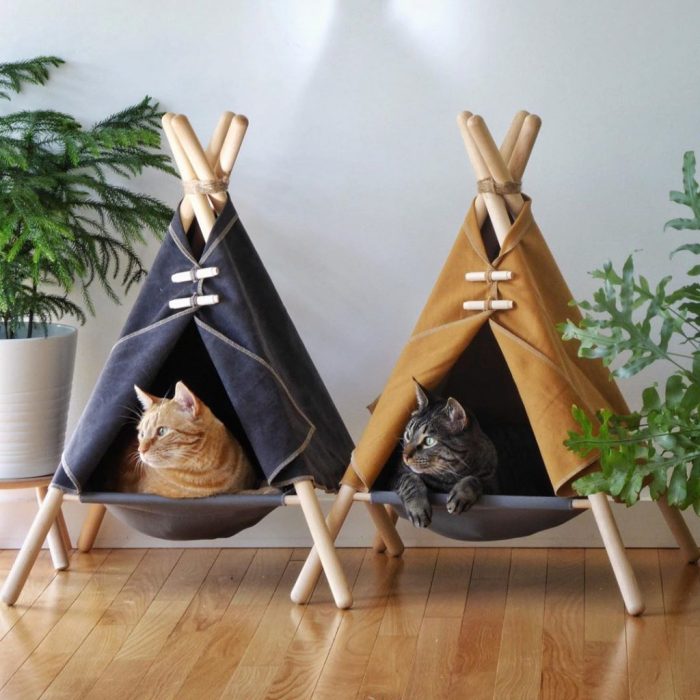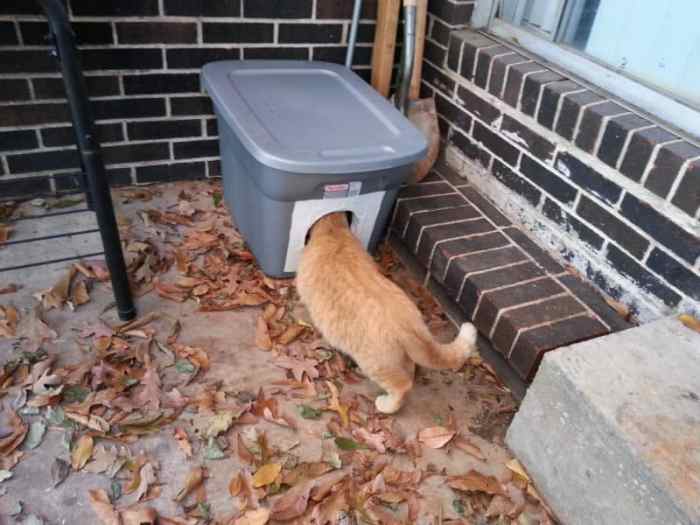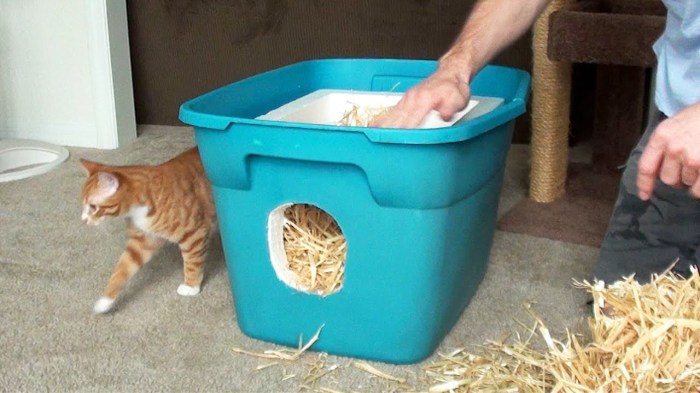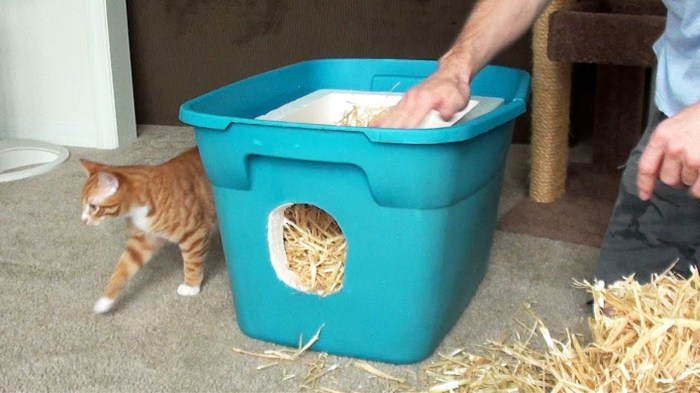Feral cat house DIY is a rewarding way to help these often-overlooked animals thrive. Feral cats, unlike their domesticated counterparts, face unique challenges in the wild, making it essential to provide them with a safe and comfortable space to call home. This guide explores the steps involved in building a feral cat house, from understanding their needs to incorporating safety features and cost-effective solutions.
By crafting a well-designed and strategically placed shelter, you can make a tangible difference in the lives of feral cats, offering them protection from the elements, predators, and the harsh realities of outdoor life.
Understanding Feral Cat Needs

Feral cats are cats that have lived independently without human care for a significant portion of their lives. They have developed unique needs and behaviors that differ from domesticated cats. Providing a safe and comfortable shelter for feral cats is crucial to their well-being and survival.
Essential Considerations for Feral Cat House Design, Feral cat house diy
Designing a feral cat house requires careful consideration to meet the specific needs of these independent animals. Feral cats need a space that provides shelter, security, and comfort.
- Location: Choose a location that is secluded and provides protection from the elements, predators, and human disturbance. A quiet corner of a yard or under a porch is ideal.
- Size: The house should be large enough for the cat to turn around comfortably and lie down. A minimum size of 2 feet by 2 feet is recommended.
- Materials: Use durable materials that can withstand the elements and resist scratching. Wood, metal, or plastic are suitable options.
- Entry and Exit: Provide a small, secure entry and exit point that allows the cat to easily enter and exit but prevents larger animals from entering. A cat door or a small opening near the ground is ideal.
- Ventilation: Ensure proper ventilation to prevent moisture buildup and mold growth. Small vents or openings in the walls or roof can provide adequate ventilation.
- Insulation: Insulate the house to provide protection from extreme temperatures. Use insulation materials like foam board or fiberglass insulation.
Providing Shelter, Food, and Water
Providing shelter, food, and water is essential for the survival of feral cats. A well-designed feral cat house can serve as a safe haven for these animals, offering them a place to rest, eat, and stay warm.
- Shelter: A feral cat house provides protection from the elements, predators, and human disturbance. A secure, well-insulated shelter is crucial for their survival, especially during extreme weather conditions.
- Food: Feral cats need a consistent source of food to maintain their health and energy levels. Provide high-quality dry or wet cat food in a covered container to prevent spoilage and deter other animals.
- Water: Access to fresh water is essential for feral cats. Place a heavy, non-tippable water bowl or a small, shallow dish with fresh water. Change the water daily to prevent contamination.
Materials and Construction
Building a feral cat house is a rewarding project that provides shelter and warmth for these often-overlooked creatures. The right materials and construction techniques are crucial for creating a safe and comfortable haven.
Choosing Suitable Materials
The choice of materials for your feral cat house depends on your budget, available resources, and the climate in your area. Here’s a breakdown of common materials and their pros and cons:
- Wood:
- Pros: Durable, readily available, easy to work with, provides good insulation.
- Cons: Can be susceptible to rot and moisture damage, requires regular maintenance, can be more expensive than other options.
- Plastic:
- Pros: Water-resistant, lightweight, relatively inexpensive, easy to clean.
- Cons: Can be brittle and prone to cracking, may not provide as much insulation as wood, can be less aesthetically pleasing.
- Metal:
- Pros: Durable, long-lasting, can withstand harsh weather conditions, relatively easy to maintain.
- Cons: Can be more expensive than other options, can be cold in winter, can be noisy in windy conditions.
- Recycled Materials:
- Pros: Eco-friendly, cost-effective, can be creative and unique.
- Cons: May require more effort to assemble, may not be as durable as other materials, availability may be limited.
Construction Steps
A simple feral cat house can be built with basic tools and materials. Here’s a step-by-step guide:
- Design and Measurements:
- Decide on the size and shape of your cat house. A standard size is about 2 feet wide, 2 feet deep, and 1.5 feet high. You can adjust these dimensions to accommodate multiple cats or larger breeds.
- Sketch out your design on paper, including the door opening, ventilation holes, and any other features you want to include.
- Cut and Assemble the Frame:
- Using your design as a guide, cut the wood for the frame using a saw. The frame should consist of four walls, a floor, and a roof.
- Secure the frame pieces together using screws or nails.
- Add Insulation:
- To keep the house warm in winter, insulate the walls and floor with a layer of fiberglass batting or foam insulation. You can also use old blankets or towels for insulation.
- Place the insulation between the frame pieces and secure it with staples or glue.
- Create the Roof:
- Cut the roof panels from wood or plywood and attach them to the frame using screws or nails.
- For added weather resistance, you can cover the roof with roofing shingles or tar paper.
- Construct the Door:
- Cut a door opening in one of the walls, making it large enough for a cat to enter and exit easily.
- Create a simple door using a piece of wood or plywood and attach it to the frame with hinges.
- You can use a piece of metal or plastic to make a flap for the door, or you can simply leave it open.
- Finish and Weatherproofing:
- Seal any gaps or cracks in the frame with caulk or weatherstripping to prevent drafts.
- Paint or stain the exterior of the house to protect it from the elements and enhance its appearance.
- Add a layer of sealant to the roof to ensure it is waterproof.
Weatherproofing and Insulation
A weather-resistant and insulated cat house is essential for providing a comfortable and safe environment for feral cats, especially during harsh weather conditions. Here are some tips for creating a well-protected shelter:
- Insulation: As mentioned earlier, using insulation materials like fiberglass batting, foam insulation, or even old blankets and towels can significantly improve the warmth of the house, especially during winter.
- Ventilation: While insulation is crucial for warmth, it’s also important to ensure adequate ventilation to prevent moisture buildup and mold growth. Include ventilation holes on the roof or sides of the house, covered with mesh screens to prevent rain and debris from entering.
- Waterproofing: Use a waterproof sealant on the roof and any exposed wood surfaces to protect the house from rain and snow. A layer of tar paper or roofing shingles on the roof can also provide additional waterproofing.
- Placement: Choose a sheltered location for the house, such as under a porch or overhang, to minimize exposure to rain, wind, and direct sunlight.
Remember, a well-constructed feral cat house can provide a safe and comfortable refuge for these animals, allowing them to thrive in their environment.
Design Considerations

A well-designed feral cat house will provide a safe and comfortable haven for these animals, encouraging them to use it regularly. The structure should prioritize safety, comfort, and ease of access for the cats.
Entrance and Exit
The entrance and exit of the feral cat house are crucial for its functionality. A secure entrance prevents predators from entering and protects the cats inside. A well-designed exit allows cats to move freely in and out of the house without feeling trapped.
- Size and Shape: The entrance should be large enough for a full-grown cat to pass through comfortably, but not so large that it allows predators easy access. A round or oval shape can help deter predators.
- Location: The entrance should be positioned on a side of the house that is sheltered from the elements.
- Protection: Consider adding a flap or a small overhang above the entrance to provide additional protection from rain and snow.
- Multiple Entrances: For larger houses, consider adding multiple entrances, providing cats with more options for entry and exit.
Features for Comfort and Safety
Adding features that enhance comfort and safety can encourage cats to use the house more often.
- Elevated Sleeping Platforms: A raised platform provides a safe and dry place for cats to sleep. The platform should be high enough to prevent water from pooling on it.
- Enclosed Spaces: A small enclosed space within the house can provide a sense of security for cats. It can be a small box or a compartment within the house itself.
- Insulation: Insulation can help keep the house warm in the winter and cool in the summer. Consider using materials like straw, wood shavings, or recycled materials.
- Ventilation: Adequate ventilation is important to prevent moisture buildup and mold growth. Ensure there are openings for air circulation, but be careful not to make them too large, as this can allow predators to enter.
Incorporating Natural Elements
Natural elements can make the feral cat house more appealing and provide additional benefits.
- Branches: Adding branches inside the house can provide cats with scratching posts and places to climb. They also offer a natural feel and can contribute to the overall aesthetic of the house.
- Rocks: Placing rocks inside the house can provide a sense of security for cats. They can also be used to create different levels within the house, offering cats more options for exploring and resting.
- Plants: Certain plants can be used to deter pests and add a touch of nature to the house. However, be sure to choose plants that are non-toxic to cats.
Placement and Integration
The placement of your feral cat house is crucial for its effectiveness. Consider the needs of the cats and the surrounding environment to ensure the house is both accessible and safe.
Think of the cat house as an extension of their natural habitat, a place where they can feel comfortable and secure. By strategically placing the house and blending it with the environment, you can encourage cats to use it and make them feel safe.
Building a feral cat house is a rewarding project, giving these creatures a safe haven from the elements. Just like taking care of yourself, giving back to the community can be fulfilling. Sometimes, a little pampering is needed, and a DIY under eye mask like this one can be just the thing to help you unwind after a long day of building.
Once you’ve finished your project, remember to check on your feral cat house regularly to ensure it’s still providing a safe and comfortable space.
Choosing the Ideal Location
The location of your cat house is essential for its success. You want to place it in an area that meets the cats’ needs for shelter, food, and water while also being safe and accessible.
- Near Food and Water Sources: Cats will be more likely to use the house if it is close to food and water. Consider placing it near a feeder or water source, or even near a garden or yard where they can find natural sources of food.
- Protection from the Elements: The house should be placed in a location that offers protection from rain, wind, and extreme temperatures. Consider placing it under a tree, bush, or overhang for added protection.
- Privacy and Security: Cats need a sense of security and privacy. Place the house in a quiet and secluded location away from heavy foot traffic, loud noises, and potential predators.
- Accessibility: The house should be easily accessible to the cats. Place it in an area where they can easily enter and exit, and avoid placing it in a location that is difficult to reach.
Camouflaging the House
To encourage cats to use the house, it’s important to make it feel as natural as possible. This can be done by blending the house with the surrounding environment.
- Paint or Stain: Paint the house a color that blends with the surroundings. Consider using earth tones like brown, green, or gray.
- Natural Materials: Use natural materials like wood, bark, or stone to construct the house. These materials will help the house blend in with the natural environment.
- Plant Cover: Plant shrubs or flowers around the house to help conceal it. Choose plants that are native to the area and that will provide cover for the cats.
- Placement: Place the house near natural features like rocks, trees, or bushes. This will help the house blend in and feel more natural.
Creating a Safe and Accessible Area
To ensure the safety and accessibility of the cat house, you need to create a safe and welcoming space around it. This means removing any potential hazards and making the area easy for cats to navigate.
- Remove Potential Hazards: Clear the area around the house of any potential hazards such as sharp objects, poisonous plants, or chemicals.
- Provide a Clear Path: Make sure there is a clear path leading to and from the house. This will allow cats to easily enter and exit the house without encountering obstacles.
- Consider Cat-Friendly Fencing: If necessary, consider using cat-friendly fencing to create a safe and secure area around the house. This can help to keep cats safe from predators and traffic.
- Provide a Litter Box: Consider placing a litter box near the house to provide cats with a place to relieve themselves. This will help to keep the house clean and hygienic.
Maintenance and Care
Providing a safe and healthy environment for feral cats requires regular maintenance of their house. This includes cleaning, sanitizing, and monitoring their well-being.
Regular Maintenance Tasks
A consistent maintenance schedule helps keep the feral cat house clean and safe.
- Clean the house regularly: Remove any debris, food scraps, or feces. A weekly cleaning is recommended, especially during warmer months when parasites and bacteria thrive.
- Refill food and water: Ensure a consistent supply of fresh food and water, especially during extreme weather conditions.
- Inspect for damage: Check the house for any damage, including holes, cracks, or loose panels. Repair any damage promptly to prevent injury to the cats or exposure to the elements.
- Check for pests: Inspect the house for signs of pests, such as rodents, insects, or mites. Take appropriate steps to eliminate any pests found.
- Monitor for signs of illness: Observe the cats for any signs of illness, such as lethargy, loss of appetite, coughing, sneezing, or diarrhea. If you notice any unusual symptoms, contact a veterinarian or animal rescue organization for advice.
Cleaning and Sanitizing the House
Maintaining hygiene is crucial to prevent the spread of diseases among feral cats.
- Use a mild disinfectant: Clean the house with a mild disinfectant solution, such as a diluted bleach solution (1 part bleach to 10 parts water). Be sure to rinse the house thoroughly with clean water after disinfecting.
- Wash bedding: Wash bedding, such as blankets or towels, regularly in hot water and detergent. Allow bedding to dry completely before replacing it in the house.
- Remove and dispose of waste: Dispose of any feces or vomit properly. Wear gloves when handling waste to prevent the spread of diseases.
Monitoring the Health and Well-being of Feral Cats
Observing the cats’ behavior and appearance can provide insights into their health.
- Monitor food and water consumption: Note any changes in the cats’ eating or drinking habits. A decrease in appetite or water intake could indicate illness.
- Observe their energy levels: Feral cats are typically active and playful. A decline in energy levels could suggest illness or injury.
- Check for signs of injury: Inspect the cats for any signs of injury, such as wounds, limping, or difficulty breathing.
- Monitor for signs of parasites: Check the cats for signs of fleas, ticks, or other parasites. Contact a veterinarian or animal rescue organization for advice on parasite control.
Additional Features: Feral Cat House Diy

Adding extra features to your feral cat house can significantly improve its effectiveness and provide a more comfortable experience for the cats. These features can range from basic necessities like feeding stations and litter boxes to more advanced systems for monitoring and integration with other wildlife management efforts.
Feeding Stations
Providing a dedicated feeding station within the cat house is crucial for ensuring that the cats have consistent access to food. This is particularly important during harsh weather conditions or when food sources are scarce.
- Elevated Platform: Consider building a raised platform to keep the food bowls off the ground and away from moisture, dirt, and pests. This will help maintain food hygiene and prevent spoilage.
- Multiple Feeding Stations: If you have a large colony, multiple feeding stations can help reduce competition and stress, ensuring that all cats have adequate access to food.
- Shelter from the Elements: The feeding station should be located within the cat house or a sheltered area to protect the food from rain, snow, and extreme temperatures.
- Easy Access for Cleaning: The feeding station should be designed for easy access and cleaning to maintain hygiene and prevent the spread of diseases.
Litter Boxes
Providing litter boxes within the cat house is essential for maintaining sanitation and hygiene. This is especially important for large colonies, where multiple cats share the same space.
- Placement: Place litter boxes in a secluded and well-ventilated area of the cat house, away from feeding stations and sleeping areas.
- Size and Number: Choose litter boxes that are large enough for the cats to use comfortably, and provide multiple boxes for larger colonies.
- Litter Type: Use a high-quality, clumping litter that is easily cleaned and odor-absorbing. Avoid using scented litters, as they can irritate cats.
- Regular Cleaning: Regularly clean and change the litter to prevent the buildup of waste and odors. This is crucial for maintaining hygiene and preventing the spread of diseases.
Remote Monitoring Systems
Integrating technology into your feral cat house can provide valuable insights into the cats’ behavior and health. This can help you track the effectiveness of your management efforts and identify any potential issues.
- Camera Monitoring: Installing a camera inside the cat house can allow you to remotely observe the cats’ activities, identify any health problems, and monitor their overall well-being.
- Motion Sensors: Motion sensors can be used to detect cat activity within the house, providing data on usage patterns and identifying any potential changes in behavior. This information can be used to adjust feeding schedules or identify potential health issues.
- Temperature and Humidity Sensors: Installing temperature and humidity sensors can provide valuable data on the environmental conditions inside the cat house, ensuring that the cats are comfortable and safe. This is particularly important during extreme weather conditions.
- Data Analysis and Reporting: The data collected from remote monitoring systems can be analyzed to provide valuable insights into the effectiveness of your management efforts. This information can be used to optimize the design and functionality of the cat house and ensure the well-being of the cats.
Integration with Wildlife Management Efforts
Feral cat management should be part of a larger ecosystem management plan that addresses other wildlife issues.
- Bird Protection: Ensure that the cat house is designed and placed in a way that minimizes the impact on bird populations. This may involve using materials that are not attractive to birds, such as solid walls, and avoiding placement near bird feeders or nesting sites.
- Rodent Control: Feral cats can play a role in controlling rodent populations, but it is important to manage their impact on other wildlife. This may involve providing alternative food sources for rodents, such as bird feeders, to reduce their reliance on the same resources as the cats.
- Collaboration with Wildlife Organizations: Partnering with local wildlife organizations can provide valuable expertise and resources for managing feral cat populations and integrating them into broader ecosystem management efforts.
Building a feral cat house is a rewarding endeavor that can provide a vital lifeline for these resilient creatures. Remember to prioritize safety, comfort, and accessibility when constructing your shelter. By providing a safe haven, you’ll not only enhance the well-being of feral cats but also contribute to responsible animal management practices in your community.

